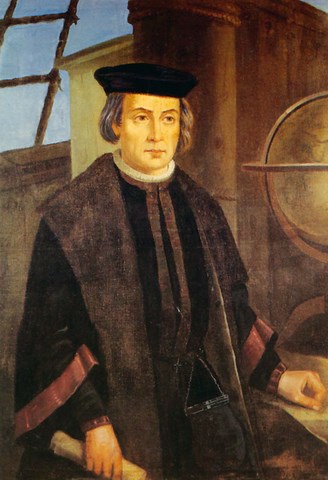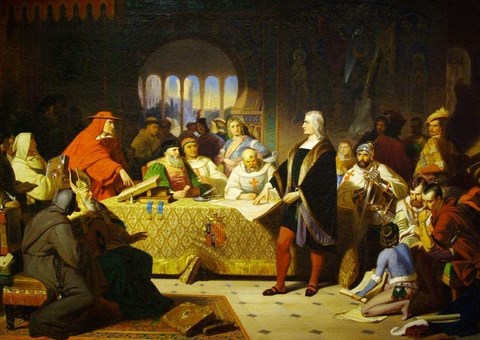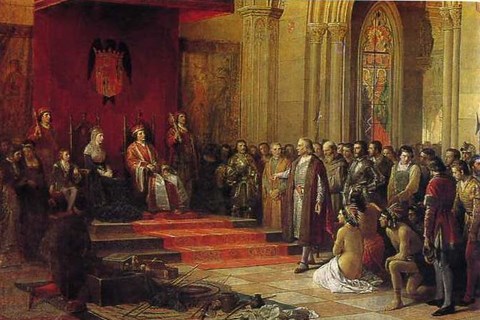The Book

A citizen of Milan, Peter Martyr d'Anghiera, a contino namely “a court attendant” and confidant of the Catholic Kings was ordered by Queen Isabella I of Castile to give a humanistic education to the young Spanish nobles living at the Court. He personally knew Christopher Columbus for many years and through his letters he makes him famous throughout Europe calling him Ligurian, but never Genoese. If he called him Ligurian, it was because that's the way he was known at the Spanish Court.
Christopher Columbus was 70 years old (1) when he died in the night between May 19th and May 20th, 1506. Almost all historians were convinced of this up to 1904 when Ugo Assereto, from Genoa, found documents in the Archive of Genoa and Savona that spoke of a wool merchant named Christopher Columbus born in Genoa around 1451-1452.
He was 16 years younger though than the Admiral of the Ocean Seas.
He, like “Christoforum Columbum de Ortoverio” from Ortovero, a town west of Albenga, was one of Columbus's many homonymous contemporaries (2).
Christopher Columbus from Chiusanico (3) overlooking Imperia), the youngest of four brothers.
Christopher Columbus from Cogoleto(4) who was not recognized as being a member of the family by Fernando, son of the Admiral, who passed through Cogoleto(5)in 1511.
Christopher Columbus from Cuccaro Monferrato(6).
Christopher Columbus from Albissola(7).
At the end of 1491, after 6 years spent in Spain, Christóbal Colón (the new surname that Columbus took in Spain), decided to go to France where he had already sent his brother Bartholomew. He wanted to propose King Charles VIII to finance his journey to the Indias and China across the Atlantic. But first he went to see his friends at the Franciscan friary of Santa María de la Rábida near Palos. There, Friar Juan Pérez convinced him to delay his departure. The Franciscan monk, the former confessor of Queen Isabella I of Castile and Leon, rode a mule to the military camp in Santa Fe where the Queen was engaged in the siege of Granada. The last Moorish king Boabdil was negotiating surrender and the crusade was drawing to a close. The Queen was now willing to finance Colón's trip and invited him to the camp in Santa Fe. Christóbal Colón arrived in December 1491 and during his audience before Isabella I of Castile and Leon and her husband Ferdinand II of Aragon, Lorenzo Galíndez de Carvajal, one of the first advisors of the Spanish monarchs, wrote in the Memorial y Registro de la Corte:
"Year 1491. This year the sovereigns made an agreement (asiento con Christóbal Colón ginovés, natural de Saona) with Christopher Colón, Genoese [i.e., Ligurian or a subject of the Republic of Genoa], born in Savona"(8).
According to the secret Archive of the Military Orders of Spain and to the Index of the Order of Santiago (9) of 1535, Don Diego Colón y Toledo, born in (natural de) Santo Domingo, a boy of 11 years of age, son of Don Diego, 2nd Admiral of the Ocean Seas, and therefore grandson of Christóbal Colón (1st Admiral Christopher Columbus), asked to wear the habit of Santiago: that of the knights of the Order of Santiago. He attached his genealogy (see below) and the sworn testimonies of Diego Méndez, Pedro de Arana and Rodrigo Barreda.
On March 8, 1535, Diego Colón y Toledo swore that his grandfather on his father's side was born in Savona (natural de Saona cerca de Génova), near Genoa.

Other documents about the birth of Admiral Christopher Columbus in Savona can be found in Franco Icardi's book Navigare rende curiosi. Cristoforo Colombo e Amerigo Vespucci secondo i loro scritti autografi e le testimonianze di chi li conobbe personalmente.
NOTES:
1 Bernáldez Andrés (+1513) in "Le scoperte di Cristoforo Colombo nelle testimonianze di Diego Alvarez Chanca e di Andres Bernaldez," Rome, Istituto Poligrafico e Zecca dello Stato, 1990, Nuova raccolta colombiana VII, chaired by Paolo Emilio Taviani, wrote at p. 206-207: “El cual dicho almirante don Cristóval Colón… estando en Valladolid el año de mil e quimientos y seis, en el mes de mayo, murió,… de hedad de setenta años (died at 70 years of age).” At p. 142-143, the parish priest Andrés Bernáldez recalled that the Admiral arrived in Spain after his 2nd trip in the month of June 1496, and "was my guest and left me some of his writings”.
2 Balbis Giannino, "Per la storia dei Colombo in Liguria nel secolo XV," in Atti del III Convegno Internazionale di Studi Colombiani, Genoa, October 7-8, 1977, Genoa, Civico Istituto Colombiano, 1979, p. 232: “July 4, 1494, Albenga… Ingauno Historical Archive, Municipal Archive of Albenga, series I, cat. 21, Council Decisions, vol. 10: Christopher Columbus from Ortovero was land tax collector on August 29, 1494 and on "June 17, 1496 creditor of 660 lire and 5 soldi from the Commune of Albenga"; "one of the 8 new councilors on October 30, 1497 to February 20, 1498... Columbus was present 15 times and absent 5 times," when Admiral Columbus was in Seville, Spain, preparing for his third trip.
3 Calzamiglia Luciano Livio, "Chiusanico e Colombo: raccolta di scritti colombiani," Imperia, 1991, p. 65, which refers to documents about Domenico Columbus whose sons were Diego, Giovanni, Bartholomew and Christopher: 4th born son. The Admiral was the first born of three brothers.
4 Memorial del Pleito sobre la sucessión, in Real Academia de la Historia de Madrid, 9/1267, no. 1211, p. 184: On June 22, 1582, Bernardo Colombo from Cogoleto collected the statements of six witnesses before Antonio de Franquis, notary, and Giovanni de Zerbino, who testified that Nicolao Columbus from Cugureo (Cogoleto) was the father of Bartholomew and Christopher Columbus. Bernard from Cogoleto stated that he was a descendant of one of the sons of Bartholomew. These documents were filed in Madrid with the Court ruling on the Admiral's succession. However, Bernardo Columbus from Cogoleto did not know that Bartholomew, the Admiral's brother, stated in a codicil to his will dated August 13, 1511, written in the palace of the Viceroy of Santo Domingo, that his only daughter Maria had died and that he had no other children. Meanwhile, around April-May 1583, Bernardo from Cogoleto apologized to the Court of Madrid saying that he could neither read nor write and that he had to change his first deposition. In a second deposition he stated that Bartholomew and Christopher Columbus were the sons of Domenico and not Nicolao Columbus and that Bartholomew had three children, Antonio, Bernardo and Masino. The Court of Madrid accused Bernard of document forgery, and sentenced him to prison until his expulsion from Spain in September 1584.
5 Colombo Fernando, Le Historie della vita e dei fatti dell’Ammiraglio Don Cristoforo Colombo, [translated into Italian by Alfonso de Ulloa in Venice, in 1571], volume I, Rome, Istituto Poligrafico e Zecca dello Stato, 1990, (Nuova raccolta colombiana VIII, volumes I and II), p. 22-23.
6 Historical Archive of the Municipality of Casale Monferrato, Dalla Valle Archive, 685, 4, parchment, deed of Cristoforo de Pavonibus, notary, in Canepa Pietro, "Cuccaro ieri e oggi," Cuccaro, PiC, 2011. On January 24, 1444, Domenico Colombo of the joint lords of Cuccaro Monferrato adopted (because he had no sons) Luchino Columbus, husband of his daughter Bartolomea. In his will dated June 1, 1450, Domenico Columbus left as his sole heir his son-in-law Luchino. In a deed: "The noble Franceschino [brother of Domenico] sanctions and approves the adoption of Luchino as well as Domenico's will... even if this will were to comprise things that may be detrimental to Franceschino given the nature of the feud to which Luchino may not succeed by law, since Franceschino or his heirs shall succeed." In other words, Franceschino would never have declared himself to be Domenico's legitimate heir, if the latter had had sons: the alleged Christopher, Giacomo and Bartholomew. Domenico Columbus died in 1451 when Christopher Columbus (the future Admiral) was 5 years old; his brother James was young and his brother Bartholomew was not born yet. The Dalla Valle Archive was brought as a dowry by the great-granddaughter of Domenico Columbus, Pantasilea junior, to her husband Rolando Dalla Valle, a leading jurist in the 16th century and Chairman of the Senate of Monferrato. However, in his numerous writings, he never made any mention of his alleged great-uncle Christopher Columbus, who never appears in any of the documents of the Dalla Valle Archive. In 1584, 39 witnesses from Monferrato told by hearsay (131 years later) that Domenico Colombus allegedly had 3 children, Christopher, James and Bartholomew. These three alleged sons are never mentioned in any document of the Columbus family from Cuccaro.
7 Gianni Venturi from Albissola Marina found evidence in the municipal archives of a land registry dated 1567 of Pian del Pero (in Albisola Superiore, overlooking Luceto toward Stella). It mentions a plot of land with farmhouse belonging to the Columbus heirs, amongst whom a Christopher Columbus, who was believed to be a grandson of the Admiral. However, the Admiral never said anything about a son born in Albisola. If he had had this son, he would definitely had asked the King of Spain to give him a noble title as he had done before for his first-born Diego, born in Portugal, and his second-born Fernando, a natural son he had from a woman from Cordoba.
8 Anales Breves del reinado de los Reyes Católicos Don Fernando y Doña Isabel que dejó manuscritos el Dr. D. Lorenzo Galíndez de Carvajal de su Consejo y Cámara, de los Reyes Doña Juana y Don Carlos, su hija y nieto, Correo Mayor de los reinos del Perú… edit. por el erudito del XVIII, don Rafael Floranes Robles y Encinas, señor de Tavaneros… año 1787. Colección de documentos inedito para la Historia de España, 1851, t. XVIII, p. 276-277 in Guadalupe Chocano Higueras, La cuna y orígenes de Christóbal Colón, Madrid, Palafox & Pezuela, 2004, p. 249-250 and note 348 which cites the Memorial y Registro de la Corte of the Kings of Spain: “año 1491, Y este año tomaron los Reyes asiento con Cristóbal Colón ginovés, natural de Saona, sobre el descubrimento de las Indias e Islas del Mar Oceano, de que tanta honra y provecho se ha seguido a estos reinos”. The Castilian word asiento means contract, but also contractual remuneration. The French-born American historian Henry Harrisse saw the original manuscript at the Bibliothèque Nationale in Paris, no. 6964, sheet 5. In his Christophe Colomb: son origine, sa vie, ses voyages, sa famille & ses descendants d'après des documents inédits tirés des archives de Gênes, de Savone, de Séville et de Madrid : études d'histoire critique, Paris, E. Leroux, 1884, tome 1, p. 156, note 1, he wrote: “de toutes les assertions qui ont été produites depuis un siècle en faveur de dix localités au moins de la Rivera, celle qui désigne Savone comme lieu de naissance de Christophe Colomb est à peu près la seule qui repose sur des documents se rapportant incontestablement au découvreur du Nouveau-Monde […] Savone, désignée à une époque aussi reculée que celle où écrivait Galindez de Carbajal, est un fait assez singulier. Il est possible que, dévoyé par l'homonyme, ce chroniqueur ait fait confusion, et, comme Gregorio Lomellino, partagé l'opinion qui, à Lisbonne, en 1476, attribuait une origine savonésienne à l'amiral français Guillaume de Caseneuve, connu alors seulement sous le nom de Colombo… [this French admiral went by the name of Columbus: the name of the most famous corsair of his times: Christopher Columbus]. Finally, Henry Harrisse quotes the phrase: K Xpval Colon ginoves natural de Saona... [affirming that he had read it in the manuscripts section] MS. de la Bibliothèque Nationale de Paris, no 6964, feuillet 5 [he found it catalogued this way before 1884], et dans la Colección de documentos ineditos para la historia de España, tome XVIII”.
9 AHN (Archivo Histórico Nacional de Madrid), Órdenes Militares, Indice de los caballeros que han vestido el habito de Santiago con sus genealogías correspondientes, fol. 46 in the first of the 8 volumes, that start from the year 1501, kept in the Archivo Secreto de la Orden de Santiago. See also in Italian Uhagón Francisco, "La patria di Colombo secondo i documenti degli Ordini Militari di D. Francesco R. De Uhagón ministro del Tribunale e del Consiglio degli Ordini, cavaliere e professo dell’Ordine di Calatrava: versione italiana di Giovanni Battista Garassini vice segretario della Società di Storia Savonese," Savona, Lodovico Bassetti, 1892, p. 42-48: oath taken by Don Diego Colón y Toledo with the Military Order of Santiago (St. James).


